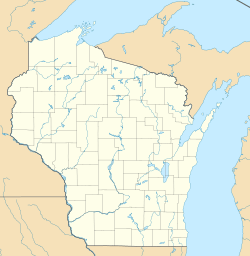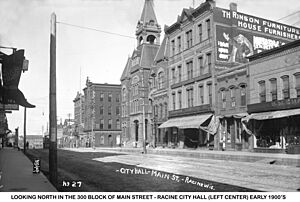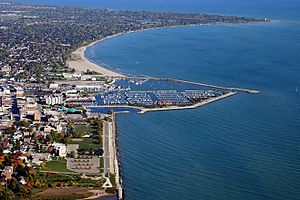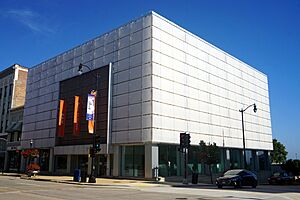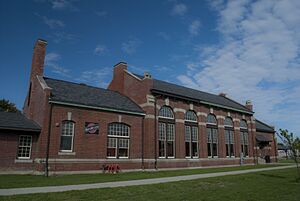Racine, Wisconsin facts for kids
Quick facts for kids
Racine, Wisconsin
|
||
|---|---|---|
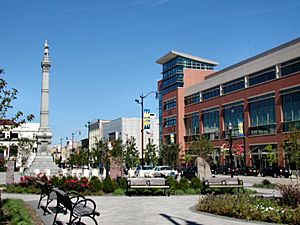
Monument Square
|
||
|
||
| Nickname(s):
The Belle City of the Lakes, The Kringle Capital of America, Kringleville, Invention City
|
||
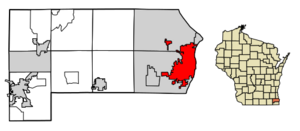
Location of Racine in Racine County, Wisconsin.
|
||
| Country | United States | |
| State | Wisconsin | |
| County | Racine | |
| Incorporated (village) | February 13, 1841 | |
| Incorporated (city) | August 8, 1848 | |
| Area | ||
| • City | 15.66 sq mi (40.56 km2) | |
| • Land | 15.47 sq mi (40.08 km2) | |
| • Water | 0.18 sq mi (0.48 km2) | |
| Elevation | 618 ft (188 m) | |
| Population
(2020)
|
||
| • City | 77,816 | |
| • Rank | 5th in Wisconsin | |
| • Density | 4,960.26/sq mi (1,915.13/km2) | |
| • Urban | 133,700 (US: 239th) | |
| • Metro | 195,041 (US: 221st) | |
| Time zone | UTC−6 (CST) | |
| • Summer (DST) | UTC−5 (CDT) | |
| ZIP Codes |
53401–53408
|
|
| Area code(s) | 262 | |
| FIPS code | 55-66000 | |
| GNIS feature ID | 1572015 | |
Racine is a city in Wisconsin, United States. It is the main city of Racine County. The city sits on the shore of Lake Michigan, where the Root River flows into it. Racine is about 22 miles south of Milwaukee and 60 miles north of Chicago.
In 2020, Racine had a population of 77,816 people. This makes it the fifth-largest city in Wisconsin. Racine is also the main city of the Racine metropolitan area, which includes all of Racine County. This area is part of the larger Milwaukee combined statistical area.
Racine is home to many important companies. These include Case Corporation (heavy equipment) and S. C. Johnson & Son (cleaning products). Other companies like Dremel and InSinkErator (which makes garbage disposals) are also based here. Historically, the city was known for the Horlicks malt factory, where malted milk balls were created. Little Golden Books were also printed in Racine. Famous architect Frank Lloyd Wright designed several buildings in the city.
Contents
History of Racine
People have lived in the Racine area since the last Ice Age. Later, Native American tribes like the Miami and Potawatomi lived here. They moved into the area because of the French fur trade.
In 1674, Father Jacques Marquette and his team camped at the mouth of the Root River. They were the first Europeans known to visit this area. Other explorers like René-Robert Cavelier, Sieur de La Salle also visited. A trading post was set up near Lake Michigan in 1791.
After the Black Hawk War, people from New York and New England settled in the Racine area. In 1834, Captain Gilbert Knapp founded a settlement called "Port Gilbert." It was located where the Root River meets Lake Michigan. Many settlers from New England soon arrived and built cabins.
The Native Americans called the Root River area "Kipi Kawi" or "Chippecotton." The name "Port Gilbert" was not popular. In 1841, the community became the village of Racine. This name comes from the French word for "root." In 1848, when Wisconsin became a state, Racine officially became a city.
Education and Freedom
Racine College, an Episcopal school, was founded in 1852. It closed in 1933. Its buildings are now part of the DeKoven Center. Also in 1852, Racine High School opened. It was the first public high school in Wisconsin. It was replaced by Washington Park High School in 1926.
Before the Civil War, Racine was known for opposing slavery. Many enslaved people found freedom by passing through the city on the Underground Railroad. In 1854, Joshua Glover, an escaped enslaved person living in Racine, was arrested. People from Racine and Wisconsin helped him escape from jail in Milwaukee. He then went to Canada. This event led to legal problems and helped increase tensions before the Civil War.
Racine's Industries and Inventions
Racine quickly became a city of factories. Early industries included making machines to separate grain from wheat. Important business leaders like J. I. Case and S. C. Johnson & Son started here. Racine's harbor was also very important for shipping in the late 1800s.
Racine was also an early center for making cars. Some of the world's first cars were built here. In 1887, malted milk was invented in Racine by William Horlick. The garbage disposal was invented in 1927 by John Hammes, who founded InSinkErator. This company still makes millions of garbage disposals in Racine.
S.C. Johnson & Son's headquarters were designed by Frank Lloyd Wright in 1936. Wright also designed other buildings in Racine, like the Wingspread Conference Center. Today, you can take public tours of the Case New Holland factory in Racine. They build tractors there.
Historic Places to See
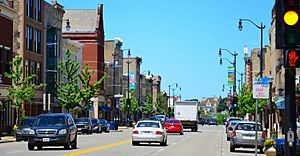
Racine has many historic buildings. The Old Main Street Historic District is a special area. Some famous buildings include the Badger Building and St. Patrick's Roman Catholic Church.
Frank Lloyd Wright designed the Johnson Wax Headquarters building in Racine. This building was very new and exciting in its design. Wright also designed the Research Tower on the SC Johnson campus. It is one of only two tall buildings he designed. The Golden Rondelle Theater was moved to Racine after being at the 1964 New York World's Fair.
The Racine Art Museum is a modern building that used to be something else. It glows at night because of its special panels. The OS House, a private home, has also won awards for its modern design.
Famous Historic Buildings
- Hansen House
- Memorial Hall
- St. Patrick's Roman Catholic Church
- Wind Point Lighthouse
- YMCA Building
- Racine Depot
Geography and Climate
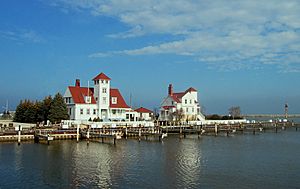
Racine covers about 15.66 square miles. Most of this is land, with a small amount of water.
Racine has a climate with warm summers and cold winters. It rains or snows pretty evenly throughout the year. Summers are a bit wetter and more humid.
People and Culture
| Historical population | |||
|---|---|---|---|
| Census | Pop. | %± | |
| 1850 | 5,107 | — | |
| 1860 | 7,822 | 53.2% | |
| 1870 | 9,880 | 26.3% | |
| 1880 | 16,031 | 62.3% | |
| 1890 | 21,014 | 31.1% | |
| 1900 | 29,102 | 38.5% | |
| 1910 | 38,002 | 30.6% | |
| 1920 | 58,593 | 54.2% | |
| 1930 | 67,542 | 15.3% | |
| 1940 | 67,195 | −0.5% | |
| 1950 | 71,193 | 5.9% | |
| 1960 | 89,144 | 25.2% | |
| 1970 | 95,162 | 6.8% | |
| 1980 | 85,725 | −9.9% | |
| 1990 | 84,298 | −1.7% | |
| 2000 | 81,855 | −2.9% | |
| 2010 | 78,860 | −3.7% | |
| 2020 | 77,816 | −1.3% | |
| U.S. Decennial Census 2020 census |
|||
After the Civil War, many European immigrants came to Racine. These included people from Denmark, Germany, and Czech Republic. Later, African Americans and Hispanics also moved to the city.
Racine has the largest Danish population in North America. The city is famous for its Danish pastries, especially kringle. Several local bakeries that make kringle have been shown on the Food Network. In 2010, President Barack Obama even visited a Danish bakery in Racine.
Arts and Entertainment
Racine has many places for arts and culture. These include museums, theater groups, and music organizations.
The Racine Art Museum has a very large collection of modern craft art. Its other campus, the Wustum Museum of Fine Arts, shows art from local artists. The Racine Arts Council also has exhibitions.
The Racine Theater Guild puts on plays and musicals every year. They also have a children's theater. The Over Our Head Players theater hosts a playwriting contest called Snowdance. People from all over the world send in plays for it.
The Racine Symphony Orchestra performs concerts throughout the year. Local bands play free concerts in Monument Square during the summer.
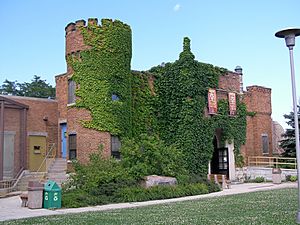
Education in Racine
Public Schools
The Racine Unified School District runs Racine's public schools. It has many elementary, K-8, and high schools. About 16,000 students attend these schools. The district offers special programs like International Baccalaureate and Montessori.
Private Schools
Private schools in Racine include:
- Racine Lutheran High School
- St. Catherine's High School
The Prairie School is a private school located nearby in Wind Point.
Colleges and Universities
University of Wisconsin–Parkside is located south of Racine. It was created by combining smaller college campuses from Racine and Kenosha. Gateway Technical College also has a campus in downtown Racine. It serves students in the southeastern part of Wisconsin.
Sports and Traditions
The Racine Legion was a professional football team. They played in the National Football League from 1922 to 1924. They played their games at Horlick Field.
Prom Celebrations
Racine is known for its big prom celebration. Students from all the high schools in the city have a large after-prom party. This tradition was featured on the radio show This American Life and in a documentary called The World's Best Prom. Since 2013, Racine has also hosted a special needs prom called "A Night To Remember."
Media and News
Racine has its own daily newspaper, The Journal Times. There are also local radio stations like WVTY (country music) and WKKV-FM (urban contemporary). WGTD (91.1 FM) is a public radio station that covers news for Racine and Kenosha.
The city has one television station, WMLW-TV (Channel 49). It shows different programs and covers southeastern Wisconsin. Another show, Racine & Me, focuses on topics important to Racine residents.
City Services and Transportation
Water Supply
Racine gets its drinking water from Lake Michigan. In 2011, the city's water was named the best-tasting tap water in the United States.
Getting Around
The city's public transportation system is called the Belle Urban System, or "BUS." Taxi services are also available.
For train travel, Racine is served by Amtrak's Hiawatha train. You can catch it at the Sturtevant station in Racine County. You can also take a bus to the Kenosha Metra station for trains to Chicago.
Airport
Batten International Airport (KRAC) is a public airport in Racine. It is one of the largest privately owned airports in the United States. Racine's airport can handle customs for international flights. For commercial flights, people use O'Hare International Airport or General Mitchell International Airport.
Sister Cities
Racine has special connections with cities around the world. These "sister cities" are:
Notable People from Racine
Images for kids
-
Kringle from Racine
See also
 In Spanish: Racine (Wisconsin) para niños
In Spanish: Racine (Wisconsin) para niños



